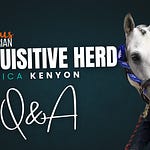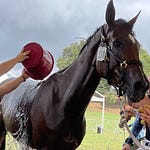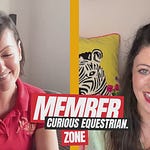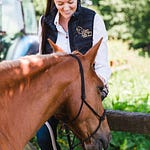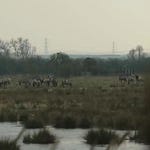Nearly 60 years of breeding horses taught Jeanette Gower that the kindest thing you can do for a foal is prepare it for an uncertain world.
Why do we persist with the notion of "forever homes"? Australian Stock Horse breeder Jeanette Gower has spent nearly six decades watching well-intentioned promises crumble under the weight of reality, and she's had quite enough of the fairy tale. "You can make that claim in good faith and you could have a car accident tomorrow which lands you permanently incapacitated and you can no longer look after your horses," she observes with characteristic directness.
Deep Dive
Guest: Jeanette Gower, Author of "Horse Colour Explained" and owner of Chalani Stud, Australia
Key Topics:
Why "forever homes" don't exist—and what that means for breeders
The mathematics of colour genetics versus Instagram fantasy
How a teenager's curiosity about pigeon genetics revolutionised her approach to horses
The uncomfortable truth about where unwanted horses actually end up
The Big Takeaway
"If you can't sell horses, don't breed," Jeanette states with the bluntness that comes from having bred over 300 foals and witnessed the industry's capacity for self-deception. It's not cruelty speaking—it's kindness with a spine.
The uncomfortable truth she's discovered is that "forever homes" serve human emotions rather than equine welfare. You can make that promise in perfectly good faith today and find yourself in a car accident tomorrow, permanently incapacitated and unable to care for your horses. The mathematics are unforgiving: we don't have horse shelters like dog shelters because horses cost too much to warehouse indefinitely.
The best protection for any horse isn't a promise that can't be kept, but breeding practices that create animals people genuinely want to own, training that makes them pleasant to live with, and pricing that reflects reality rather than sentiment.
Three Things That Stood Out
1. "One of the questions I always ask a buyer is, do you have a horse float?"
This might seem like administrative trivia, but consider the logic. If potential owners can't transport their horse to veterinary care in an emergency, they've failed the most basic test of preparedness. "Now that may seem incidental," Jeanette explains, "but if they've got no way of taking that horse down to the vet in a hurry when there's an emergency, that's not the sort of person I want to sell a horse to."
It's a beautifully simple filter that separates dreamers from owners. Whilst the equestrian world obsesses over finding horses the "perfect" home, Jeanette focuses on finding them competent ones. For British readers, substitute "horse float" with "trailer or lorry or transport"—the principle remains delightfully unromantic and utterly practical.
2. "You can't have a palomino unless you have the albino gene"
Here's where the Instagram generation's colour obsession meets uncomfortable mathematics. Breed for that perfect palomino and you've got a 50% chance of success—which sounds reasonable until you realise, as Jeanette puts it, "you might go 10 tries before you get that palomino because the odds might fall the other way." What happens to the nine chestnut "failures"?
Her genetics education began with pigeons, where "pigeon breeders knew exactly how colours of pigeons were produced." When she asked horse breeders what colour she might expect from her first mating, "no one could tell me with accuracy what I might get and that absolutely dumbfounded me." Sixty years later, we have genetic testing that can predict coat colour down to the base pair, yet breeders still chase rainbows.
The marketplace now rewards flashy colours over fundamentals. As Jeanette observed one frustrated seller attempting to market "a crossbred Appaloosa come Arab come Clydesdale" for dressage: "I can't think of anybody" who goes shopping for such a combination. Yet these one-off experiments continue flooding an already saturated market.
3. "We've bred well over 300 foals now... we've only had 10 or 12 colics"
These statistics should make every horse owner pause. What's Jeanette's secret? Nothing mystical—just horses "always out in paddocks, never stabled" until recently, and daily observation. When you're checking horses whilst feeding them, you notice changes immediately.
This challenges the modern assumption that more facilities equal better care. Sometimes the old ways work precisely because they maintain the human-horse connection that expensive infrastructure can erode. "You learn to watch your horses daily," she explains. "If you see their condition changing daily, you notice those things because you're looking out for them."
Deep Dive Analysis
The Genetics Revolution That Wasn't
Jeanette's journey from teenager asking basic colour questions to internationally recognised genetics expert illustrates how far we've come; and how little we've learned. In the 1960s, no one could give her a straight answer about colour inheritance. Today, we have genetic testing that reveals not just colour possibilities but disease markers and parentage verification.
Yet this knowledge explosion has created new problems. Social media breeding programmes chase exotic colours without understanding basic genetics, producing horses with no market demand. The temptation to breed the flashy overo rather than the sound, sensible horse has never been stronger.
The lesson from Jeanette's six-decade perspective? Understand the science, but remember the purpose. Colour genetics are fascinating tools for creating horses that people want to live with long-term; not Instagram content that clogs the market.
The Slaughter Conversation We're Not Having
Perhaps the most sobering aspect of our conversation was Jeanette's unflinching discussion of horse slaughter. "My concern of the really bad side is horses that go for slaughter, and that's why I think responsible breeding is really important," she states. It's the topic most of the equestrian world prefers to ignore, like relatives who drink too much at Christmas.
The mathematics are stark: horses are too expensive to warehouse indefinitely. The safety net for unwanted horses is thin to non-existent. This reality should inform every breeding decision, but it rarely does because it's easier to believe in forever homes than face the alternative.
Jeanette's approach is pragmatic rather than sentimental. She breeds for excellence because excellent horses find excellent homes. She prices realistically because overpriced horses often end up in poor situations. She maintains lifelong connections with buyers because she accepts responsibility for the lives she creates.
Training as Insurance Policy
"A horse that's well trained and calm and quiet... will always find a decent home," Jeanette explains, "but it might not be at any price." This perspective challenges the common breeder mentality of valuing horses based on bloodlines and potential rather than actual training and temperament.
The implication is significant: every horse you breed becomes your training responsibility. "You owe it to that horse because you bred it to find the best possible home for it." If you can't commit to that investment, perhaps you shouldn't breed at all.
Questions for Reflection
How do we balance emotional attachment to our horses with the practical reality that circumstances change? Jeanette's experience suggests that accepting impermanence actually leads to better outcomes for horses, because it forces us to focus on what we can control; breeding quality, training standards, and careful home selection.
Is the modern focus on colour genetics serving horses or just feeding human vanity? When breeders chase flashy colours over fundamental qualities, are we creating horses that struggle to find suitable homes? The market for a well-trained bay gelding far exceeds demand for an untrained but colourful horse with questionable breeding.
What would the horse world look like if we priced sentiment out of the equation? Jeanette's unsentimental approach, "If you can't sell horses, don't breed"—produced remarkably healthy horses with excellent homes. Perhaps there's something to learn from methods that prioritise practical outcomes over romantic notions about eternal bonds.
Join the Conversation
What struck you most about Jeanette's challenge to the "forever home" fantasy? Her unsentimental approach to breeding and selling has certainly made us reconsider how we think about horse ownership and responsibility. Share your thoughts in the comments below—particularly if you've experienced the reality of horses needing new homes despite the best intentions.
Find Jeanette's work at thinkinghorsebreeder.chalani.net and her book "Horse Colour Explained" through major retailers. Her Substack newsletter
"The Thinking Horse Breeder" provides ongoing insights into responsible breeding practices.Prefer to watch this epsiode for free with ads:






